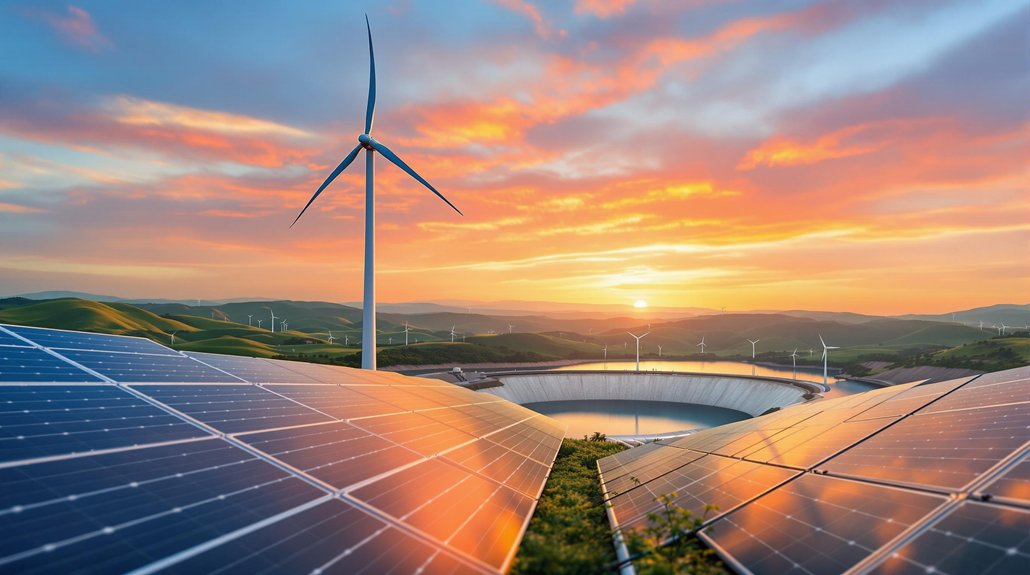Renewable energy sources are Earth's natural power systems that never run out. Solar panels soak up sunshine, wind turbines spin in the breeze, and massive dams harness flowing water. These clean alternatives to fossil fuels are getting cheaper and more efficient every year. While solar leads the growth race, hydropower remains the heavyweight champ of green electricity. New technologies like wave and tidal power hint at even more untapped potential beneath the surface.

While the world grapples with dwindling fossil fuel reserves and mounting environmental concerns, renewable energy sources have emerged as humanity's lifeline to a sustainable future. Unlike their finite fossil counterparts, these energy sources replenish naturally and offer a virtually inexhaustible supply of power while helping combat climate change. Low carbon footprint makes these sources crucial for environmental preservation. No smoke, no fuss – just clean, green energy. Hourly solar radiation exceeds the world's yearly energy consumption needs.
Solar power leads the renewable revolution, with photovoltaic panels popping up everywhere from suburban rooftops to vast desert arrays. It's the fastest-growing renewable energy source globally, and for good reason. No fuel costs, minimal maintenance – just free sunshine.
Solar power isn't just booming – it's revolutionizing energy with zero-cost fuel and simple upkeep. Nature's ultimate power source keeps on giving.
Sure, clouds can be a party pooper, but that's what energy storage is for.
Wind energy isn't far behind, spinning its massive turbines both on land and offshore. It's already the second-largest renewable electricity source after hydropower, and costs have dropped so much that it's giving conventional power sources a run for their money. Local economies benefit significantly from wind farm development and operation.
The wind industry's motto might as well be "go big or go home" – these turbines are getting enormous.
Speaking of hydropower, it's still the heavyweight champion of renewable electricity generation. Those massive dams aren't just for show – they provide stable baseload power and can ramp up quickly when needed.
Of course, they're not exactly fish-friendly, but that's the price of progress.
Geothermal energy keeps things hot and steady, tapping into Earth's natural heat for reliable power generation and heating. It's like having an unlimited underground furnace – if you're lucky enough to live in the right geological spot.
Meanwhile, biomass energy turns everything from wood to waste into useful power, though it needs careful management to avoid turning forests into fuel.
Marine energy technologies are the new kids on the block, still finding their sea legs. Wave and tidal power might be predictable, but they're fighting against corrosion, high costs, and the general crankiness of the ocean.
Still, for coastal communities, the potential is too tempting to ignore. The future of renewables is bright – and it's about time.
Frequently Asked Questions
How Much Does It Cost to Switch a Home to Solar Power?
Switching to solar isn't cheap. A typical home installation runs between $16,500 and $30,000 before incentives kick in. That's a chunk of change.
But here's the deal – federal tax credits slash 30% off the total, and local rebates can drop it even lower.
System size, equipment quality, and location all affect the final price tag.
Yearly maintenance? About $300-500.
Can Renewable Energy Completely Replace Fossil Fuels in Transportation?
Complete replacement of fossil fuels in transportation isn't feasible in the near term.
While electric vehicles and biofuels are growing, they'll likely only replace about 50% of oil use by 2040.
Hard truth: batteries can't match fossil fuel energy density yet.
Aviation especially remains a tough nut to crack – biofuels are just 0.01% of aviation fuel.
The shift's happening, but slowly.
Really slowly.
What Happens to Solar Panels and Wind Turbines After Their Lifespan?
Most solar panels and wind turbines end up as waste – pretty ironic for "green" energy.
Solar panels pile up in landfills, leaching toxic materials like lead and cadmium.
Wind turbine blades are a nightmare too, with thousands being buried annually.
Though 85% of turbine parts can be recycled, those massive blades are nearly impossible to process.
The recycling industry isn't ready, and costs are too high.
Landfills win.
How Do Weather Changes Affect Wind and Solar Energy Production?
Weather changes hit renewable energy hard.
Solar panels lose efficiency when temperatures soar – about 0.5% less power for each degree above 77°F. Clouds? They're solar's nemesis, slashing output by up to 90% on gloomy days.
Wind energy's no picnic either. Too little wind, no power. Too much, turbines shut down.
Mother Nature keeps everyone guessing, with seasonal patterns throwing more curveballs into the energy mix.
Which Countries Currently Lead in Renewable Energy Technology Development?
China dominates global renewable tech, period.
They're crushing it in solar manufacturing and wind installations.
Denmark's wind innovations are impressive – they're basically the wind wizards of Europe.
Germany's engineering prowess shows in solar tech development, while the U.S. leads in research dollars spent.
Japan's efficient solar panels and Norway's hydropower expertise round out the tech leaders.
Big money, big results.








